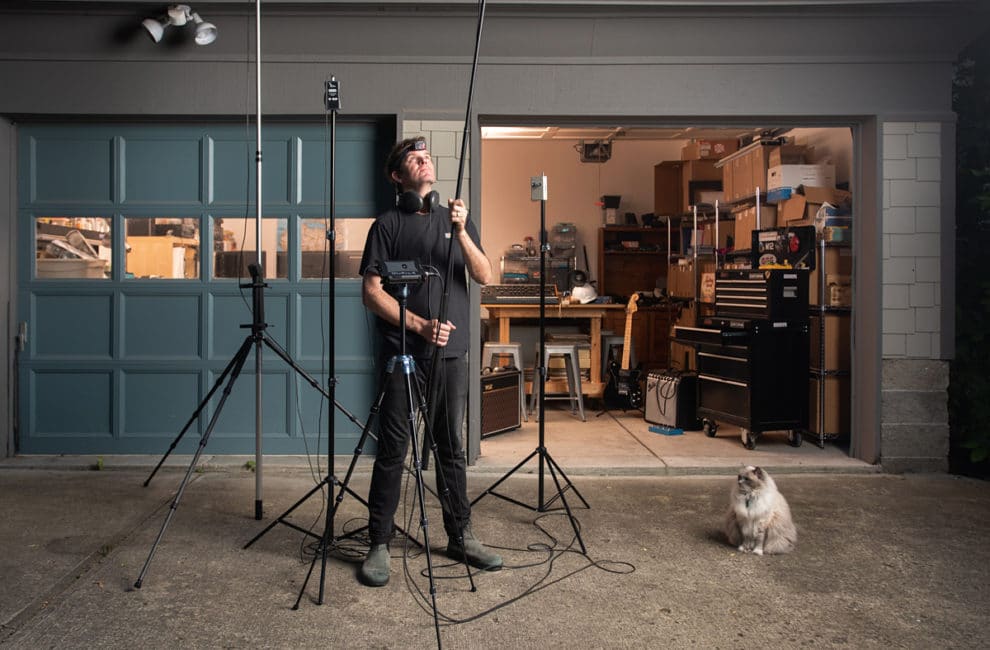
Hyatt records the ultrasonic sounds of bats with highly specialized equipment and then produces music to accompany them in his home studio, occasionally alongside his cat Remy. Photo by Matthew Gilson
Stuart Hyatt Is On A Different Wavelength

Although his projects are eccentric, Hyatt’s focus on amplifying everyday sounds has resulted in national attention.Photo by Matthew Gilson
Stuart Hyatt hears music everywhere he goes. He hears an uplifting rock song in the collective voices of children counting to 100 inside an empty grain bin. He hears a pop tune in the raucous sounds of wildlife as he and his crew traipse through the Brown County woods looking for Sasquatch. He hears a hip-hop beat in the police sirens on Washington Street in downtown Indianapolis. And as he sits in his Broad Ripple home, he can almost pick out a dance-track duet between the squirrel scratching at his window and the hammering of a construction crew working next door.
Though that last one might just be a sign of Hyatt finally succumbing to COVID-era cabin fever.
Like most people in 2020, Stuart Hyatt is feeling a little stir-crazy. Quarantined at home, he’s trying to work from his office in the garage while accommodating a spouse and two kids who are stuck at home with their work and studies as well. Unlike most people, however, the musician and artist is also trying to promote a new album. “It’s just a weird environment in which to release creative work,” he says via Zoom, sitting at the control panel of his garage studio, his reddish-brown hair disheveled. “I almost feel guilty for asking people to pay attention to it.”
Asking people to pay attention is something Hyatt hasn’t done much in his career. He’s the first to admit that recording squirrel sounds and police sirens is less than commercially viable. He’s not a touring musician who can make money on ticket sales or merchandise. He insists on pressing each project onto vinyl and wrapping it in elaborate packaging, sometimes even accompanied with a hardbound book or lavishly illustrated comic, cutting into the margins of any record sale. Hyatt is also notoriously generous in divvying up the budget among his vast roster of collaborators. And his work is almost entirely funded up front by grants or commissions from museums and state tourism boards, so at least from a financial perspective, it really doesn’t matter if anyone’s listening to the finished product or not.
Even so, people’s ears seem to be perking up lately. The National Geographic Society funded his latest project, which received an extensive and glowing review in The New York Times. Pieces from Gizmodo and The Independent followed. Interestingly, the album for which Hyatt is receiving this attention is his most unassuming to date. In fact, it’s built on a sound so high in frequency that the human ear can’t hear it: the echolocation calls of the Indiana bat.
Released in May, Ultrasonic is the eighth album in Hyatt’s Field Works series. He spent the summer evenings of 2019 with a small recording crew in the woods around the Indianapolis International Airport. They installed microphones in trees and on flagpoles and suspended them from boom stands. As the sun set and the nocturnal creatures began to stir, Hyatt pressed record. The crew couldn’t actually hear anything at the time, but they watched their equipment for signals that the winged animals were vocalizing. The next morning, when Hyatt processed the recordings, he discovered hours of bat-made chirps, whistles, and snaps that would provide the backbone of his record. “Ninety-nine percent of the population has never heard this sound,” he says. “Telling this story is really trying to open a portal into another dimension.”
Ultrasonic represents a somewhat new realm for Hyatt: activism. While his music has always highlighted overlooked people and places, with these recordings, Hyatt hopes listeners will do more than just take notice. He wants them to act. The Indiana bat is an endangered species, with just over 500,000 spread across the Midwest, Northeast, Mid-Atlantic, and South. The small creatures have been decimated by a fungal infection called white-nose syndrome. And developers have paved over many of the marshes and forests it uses as habitat.
Ultrasonic attempts to give voice to an endangered bat. But in the process, the work might end up ensuring that its composer, too, is finally heard.

While the wild is a relatively new lab for Hyatt’s work, the sounds of nature have always captured his imagination. “It’s deeply spiritual,” he says. “I don’t want to say that nature is my religion, but it is my church. Recording it is my way of understanding it, preserving it, and sharing it.”
His earliest memory is emerging from the water in a pool as a baby and the sound of the muffled deep opening up in the air above the surface. Hyatt was always fascinated by atmospheric sounds—what most people would write off as noise. In fact, he was so easily distracted that, when he was 3 years old, his parents tried to focus his attention on music. They bought him a miniature violin and lessons in the Suzuki method, which focuses on repetition and rhythm. He spent seven years mastering the instrument, but at age 10, just as the instructor was introducing him to sheet music, Hyatt decided he was tired of the violin. “I was proficient, but I couldn’t read a lick of music,” he says. “That set into motion a life of understanding, hearing, and feeling music, but being illiterate to its actual language.”
Hyatt attempted to teach himself how to play stand-up bass, tuba, trumpet, guitar, and drums, all by ear. But it was a 4-track cassette recorder lent to him by a classmate at Broad Ripple High School that would forever shape the way Hyatt approached music. Suddenly, the world was his instrument. He started by recording his own voice singing each part of a four-part harmony in the bathroom and then layering the tracks on top of each other. Then he taped the water dripping from the faucet and flowing through pipes. He hacked into his parent’s stereos and created a makeshift recording studio. He took cues from the hip-hop he listened to and started sampling different sounds and throwing them in the mix.
In 1993, Hyatt left for Eckerd College, a liberal-arts school in St. Petersburg, Florida, where he enrolled in the visual-arts program. But he never missed an opportunity to incorporate his passion for capturing and augmenting the sounds of his surroundings. On one occasion, he traveled to nearby Clearwater to visit one of the hubs of the Church of Scientology, known as the Super Power Building. He slipped a Marantz portable tape machine into his backpack and recorded his orientation. (He had to go to the bathroom midway so he could flip the cassette.) When he returned to his dorm, he listened to the playback and was exhilarated. He layered the recording with audio from a Scientology VHS tape and he added guitar and synthesizer to create what would be the first of about 20 audio collage pieces for his undergraduate thesis project.
By the time Hyatt got to graduate school at IU in 2000, his life had evolved into one all-consuming performance. Officially, his focus of study was sculpture, but everything Hyatt did in and around Bloomington incorporated some form of artistic expression. He started a band called Fantastic Pants, which featured classmates playing a toy squeeze-box, tap shoes, and a ukulele, with Hyatt on drums. (They never performed live.) He started a pirate radio station and distributed handheld FM receivers to help listeners dissolve a fictional organ located behind the ear called the Kunda Buffer which, when unlocked through enlightenment, could release the true feeling of love. When there was news of a Bigfoot sighting in Brown County, Hyatt gathered a group of grad students, outfitted them with recording equipment and uniform coveralls, and took to the woods in search of Sasquatch. “It was this crew of four people showing up to do Bigfoot investigations in the forest—it had a very Wes Anderson feel to it,” says crewmember and fellow artist Richard Saxton. “Stuart could take a quick idea and say, ‘Let’s turn it into art.’ That project was fun for us, but we were also talking to people in the community and discovering the place. Bigfoot was just an excuse to go out there.”
For all his eccentricities, Hyatt never believed in art merely for its own sake. In fact, he rejected the notion of fine art. “He felt the world of the elite was no more important than that of the everyday people,” says Saxton. “And he always had a strong sense of community and an understanding that it was an important part of being an artist. It wasn’t about being a solitary genius in a studio; it was about the connections we were making.”
A great example was Hyatt’s master’s thesis. He took over an entire floor in the IU School of Fine Arts building to create a 3,000-square-foot performance space equipped with Astroturf, bleachers, large moveable wooden structures, a digging pit packed with 4,000 pounds of dirt, video monitors, an electric car, and a massive spittoon—all of which Hyatt designed and built himself. The 8 Step Revival was built around what he deemed as the eight elements of human life, each of which was represented by an object: a block, a ball, a rake, a basket, a pole, a cup, a rope, and “goo.” For instance, the rope represented our connection to each other, and the “goo” symbolized our adaptability. People in Bloomington were invited to play catch, climb the blocks, dig for treasure with the rake, and spit into the “cup of life.” All for the simple joy of doing so—linking art to fun and happiness. “His ideas were always big, original, inspiring kinds of things,” says Jeremy Radway, a musician and high-school friend who performed at the exhibit. “But it’s one thing to have a crazy idea; it’s another to connect it to real life and real human experience. That’s what’s remarkable about everything he does: He’s always thinking about what these ideas mean to people.”

In 2010, Hyatt experienced what he calls an “intellectual midlife crisis.”Photo by Matthew Gilson
People would be the focal point of Hyatt’s early work as a professional musician. After graduating from IU with his MFA, he left Indiana to document humanity, particularly the marginalized, for a series of recordings that he produced on his own label, TEAM Records.
In 2003, the Coleman Center for the Arts brought Hyatt to rural Sumter County, Alabama, where he engaged the community in a collaborative recording session. The Clouds was an album of eight “avant-gospel” songs written by Hyatt and performed by 88 local singers from elderly church choir members to second-grade amateurs. Captured in country churches, living rooms, and a back room of the local library, the work aimed to “explore the inevitability of death and the love, fear, and beliefs that surround it.” One song, “No You Can’t Take Them,” is Hyatt playing piano and guitar while children call out a list of cherished people and objects: “And my uncle/and my bike/and my clarinet/and my mom …” For the exhibition, Hyatt decorated the room with tufts of cotton-ball clouds and took tiny photographs of each participant and affixed one to each of the 88 hammers in an upright piano so that when guests pressed a key, a different face would pop up. He then handmade 500 CD cases out of corrugated cardboard and handwrote the lyrics on fold-out liner notes he’d made from slicing up paper grocery bags. The effort earned him a surprise Grammy nomination for Best Recording Package.
His follow-up, Shrimp Attack, sent Hyatt back to St. Petersburg, to Creative Clay, a nonprofit arts center for adults with developmental disabilities. He landed on an orchestral pop sound for this album, but started experimenting with instrumentation: an inverted violin bow bouncing on the strings in a rhythmic pattern; the wheel of a skateboard being whirled and stopped. But again, humanity was the focal point. The driving rock tune “Good” featured a man named Mike who normally would only ever utter a few words singing, “Good/good stuff/big hot dog/yummy.” Another track featured the vocals of a man who would only hum into the microphone.
Hyatt’s third album was an interactive public art project in Sheboygan, Wisconsin, where he and his crew helped convert a grain silo into a recording studio that also opened up into a stage. The music for M.I.K.E. Vol. 1, a collection of country/folk songs, was written and, in part, performed by Hyatt. But the artist faded into the background as voices from the community prevailed. “He’s more like a conductor,” says Amy Ruffo, former manager at the Kohler Arts Center in Sheboygan who has continued to collaborate with Hyatt on other projects. “He’s working with people who are not artists, who he wants to engage. He wants to learn from them because that’s going to build his music.”
But while the work was groundbreaking and artistically fulfilling for Hyatt, it was hardly a commercial success. The projects were funded by grants from the Kohler Arts Center, Coleman Center for the Arts, and Eckerd College, almost all of which Hyatt put toward the production and to pay the other artists who came aboard. If he had any interest in actually selling records, it didn’t show. During that period, he spent weeks inside the Minnesota state penitentiary system recording 40 inmates and their music—more than 12 albums worth of songs that Hyatt couldn’t even commercially release due to privacy concerns. He mailed the CDs to the offenders’ families as gifts and donated some to the prison library.
By 2010, Hyatt was only 35, but he was experiencing what he calls an intellectual midlife crisis. His creative struggles were set against the backdrop of an economy still recovering from the Great Recession, when grants were scarce. So Hyatt did what any musician/performance artist does when they bottom out: He enrolled in architecture school.
In the spring of 2014, Hyatt was a third-year architecture grad student at Ball State walking along Washington Street in downtown Indy when he unwittingly found himself being a musician again. He was working on the thesis project for his master’s degree, doing site analysis for a hypothetical building that he would design. Part of the exercise was talking to the stakeholders who live and own businesses in the neighborhood. “I started interviewing people,” Hyatt says. “And I just kept recording them. It was almost like Forrest Gump—I just kept walking, 45 miles over the course of a month, collecting stories and moments. It was way more interesting than designing a building.”
Hyatt pressed a vinyl record for his thesis. Fortunately for him, his academic advisers were flexible and granted him his degree. But Hyatt would never design a single building. Instead, he embarked on a new series of compositions collectively titled Field Works. The first album, The National Road, was built on his recordings from Washington Street, Indy’s section of the national byway commissioned by Thomas Jefferson in 1806. While voices of people speaking were still prominent, these songs were centered on place, featuring a full backdrop of noises—some raw, others synthesized beyond recognition—from traffic to industrial rattling. For Born in the Ear, Hyatt traveled to Amish country in Lancaster, Pennsylvania, where he captured the sounds of agriculture and the rumble of sidewalk sweepers. Pogue’s Run traced the trickling of the waterway through the wilderness to its urban spill into the White River. In The Fair State, Hyatt commemorated Indiana’s 200th birthday by layering speeches of Hoosiers like pioneering socialist Eugene V. Debs and then-Governor Mike Pence over the sounds of the Indiana State Fair to produce a jarringly dark and scathing critique of the state’s political climate in 2016.
As the Field Works albums progressed, the humans and their voices continued to recede into an increasingly crowded instrumentation. The result was a far more ethereal sound than the old TEAM records. Hyatt, too, withdrew further into the background as he opted to enlist prominent musicians from all over the world. The recurring roster included French pianist Julien Marchal, L.A.-based harpist Mary Lattimore, Dutch sound artist Machinefabriek, Japanese electronic musician Chihei Hatakeyama, and Carmel cellist Grover Parido. “He’ll tell me what he wants in larger terms, a simple melody, and then he’ll put a keyboard in front of me,” says saxophonist and longtime collaborator Joe Terrana, who first met Hyatt in college in Florida. “Musicians play with him because they’re free to create whatever they want. Classical musicians especially like to play for him because there is no score. They’ll improvise and they’ll play something and he’ll say, ‘That’s it! Play it again!’ He has this magnetic personality. Everybody knows it’s going to be fun.”
Hyatt brought the same wide-open mindset to his selection of subject matter. In late 2017, an old friend from IU named Margo Handwerker invited him to Texas State University, where she is now director of the campus art galleries. The assignment was pretty wide open: Come down to San Marcos and propose a project. Hyatt accepted, rented a car, and just started driving around. He ventured out to the country surrounding the college town, with its rugged hills of limestone and granite. “The word ‘whimsical’ isn’t exactly right, but he follows his instincts,” says Handwerker. “He was doing these drives through hill country, and he just followed the next inspiration. Something compelled him to turn down this road, some funny sign. Going down the road, he ended up in Boerne, Texas, and found Cave Without a Name. He went there and that was it. That was going to be the project.”
For Glen Rose Formation, named for the area where the cave is found, Hyatt brought in sound engineers to walk around in the pitch black blasting low-frequency sine waves, trying to hear and feel which vibration resonated. He determined that 61.74 Hz was the cave’s frequency, and it provided the spine of the sound he would record. Topside, Hyatt dug into the cave’s history. He happened upon Mary McGrath Curry, who as a child in the 1930s, was the first person known to have found the place. He tracked Curry all the way to Alaska and flew to Sacramento to record the tale of her discovery. He enlisted veteran pedal-steel player Bob Hoffnar to play, both on the record and in the live concert, held in the cave’s throne room.
The project was something of a turning point for Hyatt. Curry’s narration notwithstanding, the cave was more than a stage and studio—it was the star. The din of humanity was fading as Hyatt’s focus turned to the wilderness.
In September 2018, Hyatt was chaperoning his son Oscar’s fifth-grade class on a field trip to Great Smoky Mountains National Park. Evening was just starting to set in, and the sky was a deep purple. A ranger led the group down into a meadow, where he stopped them and told them to look up and listen. “We didn’t hear anything,” says Hyatt. “But then he took out this white box, turned this dial, and pointed it up. There were these wonderful sounds we’d never heard before. It took me about two seconds to say, ‘That’s my next record.’”
The sounds were the calls of the park’s Indiana bats, which he later confirmed were present back home near Indy. Hyatt had already been commissioned by IUPUI to create a public art element of the “Welcoming Campus Project” to commemorate the school’s 50th anniversary. So he pitched the idea of making the campus a safe space for these endangered bats. He would install bat houses on trails near campus along the White River as a public art installation that doubled as a makeshift recording studio for his ultrasonic singers. At the unveiling, Hyatt invited about 60 people on a bus to bat feeding grounds near the airport. He gave each of them handheld detectors and let them hear the clicks and whistles for themselves. “The audience was fascinated,” says Jason Kelly, director of the IUPUI Arts and Humanities Institute. “You could tell that their understanding of the species was completely transformed over the hour and a half.”
In order to amplify that message and broaden the impact, Hyatt secured additional funding from the National Geographic Society to record what became Ultrasonic, a double album of 14 songs. The record opens with bat calls digitally manipulated to act as staccato strings, swelling organ, and layered ambient backdrop before Portland-based artist Eluvium swoops in with his actual violin. “Silver Secrets” takes flight with Lattimore’s harp flitting delicately over synthesizer and the mammal’s echolocation. The album closes with “Between the Hawthorn and Extinction,” poet Cecily Parks’s spoken-word ode to the endangered bat that leans toward lament. “Goodbye caves/Goodbye mines with coal that lit up the night/Goodbye night that the bats fly by …”
To prepare for this project, Hyatt validated his new title as National Geographic Explorer by diving into the science. He contacted Joy O’Keefe, professor of biology and director of the Center for Bat Research at Indiana State University. Hyatt followed her into the field, where he tried to soak up as much knowledge as he could, even though the exercise was frightening for him. “I am not an Eagle Scout,” says Hyatt. “I’m really a wimp. I’m trying to do better, but I’m not comfortable in pitch black with bats swarming all around me. It’s really unsettling.”
Ever the sonic explorer, Hyatt braved on, learning enough to pass on his newfound knowledge and passion for bats in a record. He scheduled promotional events and field trips that were supposed to follow the album’s release.
Then the pandemic hit.

Hyatt records the ultrasonic sounds of bats with highly specialized equipment and then produces music to accompany them in his home studio, occasionally alongside his cat Remy.Photo by Matthew Gilson
In mid-May, Indy authors John Green and Sarah Urist Green were streaming a celebration live on YouTube. Urist Green, the creator of PBS’s The Art Assignment and a former curator of contemporary art at Newfields, had just published You Are An Artist: Assignments to Spark Creation. The book’s release party was supposed to be that day in Washington, D.C. Instead, due to COVID-19, it was in the Greens’ living room via the internet.
As the video began, Green and Urist Green occupied only half of the screen; the other half was as black as a bat’s cave at midnight. This was the part of the event where Hyatt, a family friend who contributed a chapter to Urist Green’s book, was supposed to patch in for a special guest appearance. Evidently, someone on one end was having technical difficulties. But then again, knowing Hyatt …
“It might be his entrance,” said Urist Green, laughing.
“It could be,” said Green. “I wouldn’t put it past him.”
“Maybe it is,” said Urist Green. “Maybe this is going to be a big reveal … the black screen is art.”
Just then, Hyatt and his daughter, Bea, materialized in pixels to fill the void, the glitch resolved. The Hyatts toasted Urist Green and her new book, then launched into a presentation, which mirrored Hyatt’s guest chapter about graphic scores. (The representations of music through pictures and visual symbols instead of formal notation are a necessity for the untrained Hyatt.) He looped in saxophonist Terrana live from Florida. For the experiment, Hyatt had selected two pieces of music that he, Bea, and the Greens listened to and drew out scores of while Terrana muted his computer and watched in silence. The saxophonist tried to play the visual scores and see if he could at least nail down the genre. The first piece was the booming orchestral “Imperial March” from The Empire Strikes Back, which the group interpreted into sharp peaks, dots, and lines. The second was Miles Davis’s landmark jazz album Kind of Blue, which the artists drew out in smooth, quiet arcs and loops. Terrana then unmuted and, uncannily, was able to approximate loose interpretations of both.
The segment lasted about 20 minutes. Then Hyatt signed off, his world confined to his living room once again.
Hyatt knows he needs to promote Ultrasonic, but, mentally, he has already moved on. He’s currently working on arrangements for his next album, about cedar trees, for which he traveled to Durham, North Carolina; Beirut, Lebanon; and Paris, France. And he has already started gathering sounds from monitors in Alaska hoping to map the tectonic plates beneath North America for a project on seismic activity.
Obviously, there is an inherent urgency in Hyatt’s latest work on bats. The environmental conditions threatening them remain, and he’s grateful for the attention the record is getting from the media. But right now, he feels compelled forward to the next recording. The music is there. All the public has to do is listen.





